Introduction
An unsettling feature of trench combat in World War I, “Trench Raiding” was a way for units to engage in small scale surprise attacks on unsuspecting enemies, usually in the dead of night. Due to the claustrophobic nature of warfare along the Front, troops on both sides had to devise ways in which they could effectively attack and defend themselves when it came to close-quarters encounters.
Bilhook/Fascine Knife
The billhook dates back to the medieval period, where was used both as an agricultural implement and weapon. As a weapon, it was similar to a halberd and known as a “bill” or “billhook”, which was a pole with a curved blade at the end. Back then, the English were widely known for using the weapon, especially at the Battle of Flodden in 1513, where an arrow and “Bill” felled Scottish King James IV.
The billhook was also issued to some armed forces, known as the fascine knife. While its use was primarily for making fascines—rough bundles of brushwood for strengthening structures—it was an effective weapon in close-quarters.
Billhooks for sale at Ludlow market, Shropshire, England
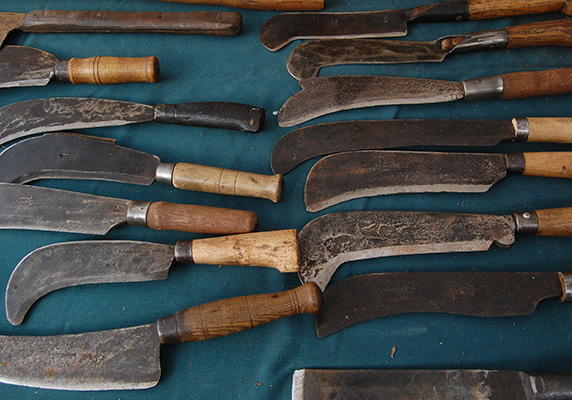
The fascine knife was a side arm issued to 17th and 19th century light infantry and artillery. Like the billhook, it was made for cutting fascines, as the name implies. The blade could be straight or curved, double edged or single edged with a sawtoothed back. For German, Prussian and Swedish forces in the 17th and 18th century, this weapon was more like a cavalry sword. The fascine knife changed over time, eventually becoming the Pioneer’s billhook in the British Army. For the Indian Army, it’s known as a Knife Gabion and serves the same purpose.
Brass Knuckles
It doesn’t get more up close and personal than brass knuckles. They work by directing the force of a punch to pinpoint areas, increasing the risk of fracture and tissue disruption. While the idea of a gauntlet or some kind of protective/attacking implement for the hand is nothing new, the Nihang Sikhs (an armed Sikh order), used an early variant of the knuckle duster in the 18th century. Later, the weapons were used during the American Civil War; soldiers would carve them from wood or cast them at camp by melting lead bullets and pouring them into a mold in the dirt.
Brass knuckles carried by Abraham Lincoln's bodyguards during his train ride through Baltimore. Carol M. Highsmith
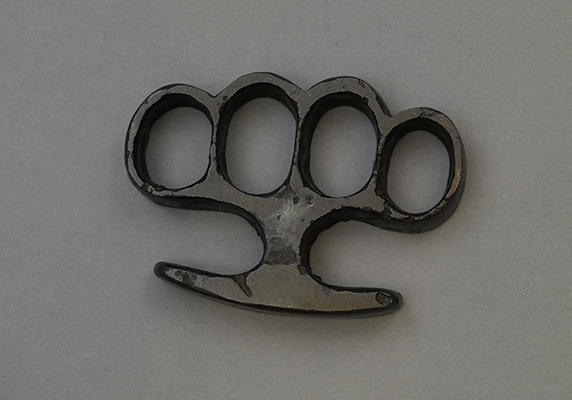
Knuckle dusters found their way into pistols, too, such as the Apache revolver used by French criminals. Then, during World War I, the US Army issued two different knuckle knives: the US model 1917 and US model 1918 Mark I trench knives.
Apache revolver – Curtius Museum, Liège. By Latente Flickr
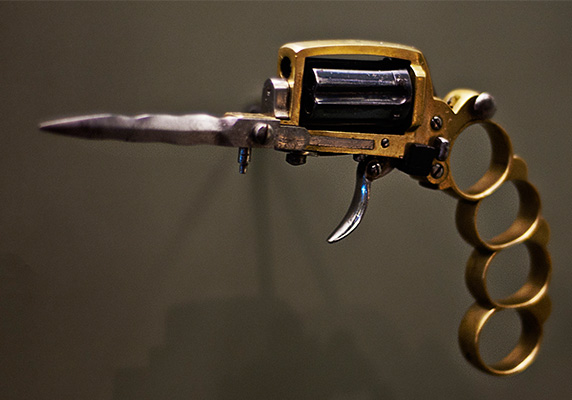
Entrenching Tool
Like brass knuckles, the entrenching has a long history in warfare. Dating back to the time of the Roman Legion, there are documents from the likes of Julius Caesar discussing their use. Way back then, they were used to dig ditches and ramparts, as well as other fortifications. When the Napoleonic Wars rolled around, soldiers would build trenches near fortifications, allowing canons to get close enough to blast a hole through the wall.
Trenches of the 11th Cheshire Regiment at Ovillers-la-Boisselle, on the Somme, July 1916. One sentry keeps watch while the others sleep. Ernest Brooks
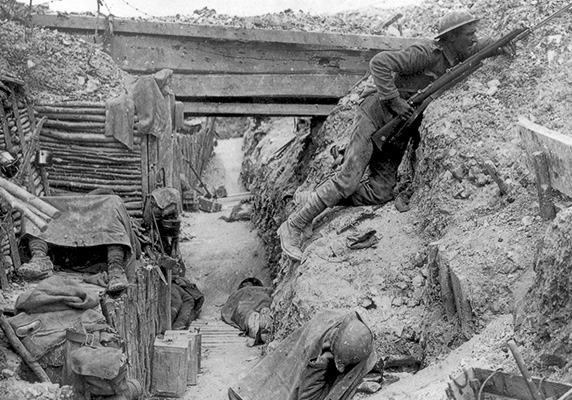
In 1870, the US Army put into practice the trowel/spade bayonet, for use as a weapon and entrenching tool. It was then refined to be carried as part of each soldier’s equipment. The idea of the entrenching tool was further refined in World War I and played a key part in trench warfare. As well as digging fortifications and latrines, it was utilized as a close combat weapon, due to the tight nature of fighting in trenches. In these instances, rifles and bayonets could be difficult to use effectively, so soldiers routinely sharpened the edges of shovels.
Mace/Trench Raiding Club
While maces seem more like a weapon that knights or barbarians used, they were effective trench raiding tools. Inspired by medieval maces, the Allies and Central Powers prominently used them during nighttime raids, as a silent way to neutralize wounded soldiers.
Selection of clubs and a flail used on the Dolomites front. By Stefano Menchiari
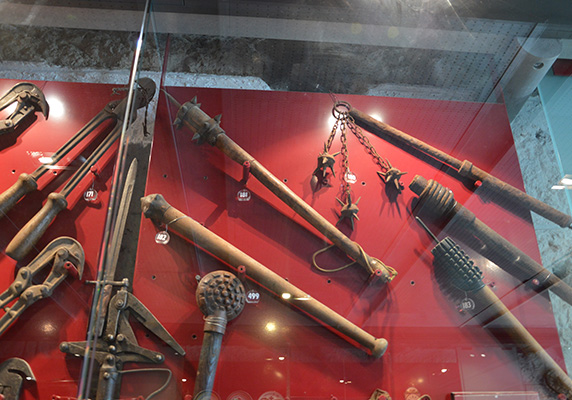
The maces themselves were usually constructed from wood and a metal object was affixed to the striking end. Another effective design compromised a stave with the end drilled out, where a lead weight was inserted, with rows of large hobnails around the circumference. The maces also had a leather strap that could be wrapped around the user’s wrist so they did not lose it. Clubs were made in bulk by regimental carpenters and metal workers behind enemy lines.
Trench Knife/Punch Dagger
Trench knives were specially designed for closer quarter skirmishes in confined areas. Most trench knives of the time were crafted by individual soldiers or ordnance blacksmiths. They were simple weapons, usually shortened and sharpened bayonets. One early knife, the “French Nail”, was created from the stakes that kept barbed wire in place.
U.S. M1917 "Knuckle Duster" trench knife and leather sheath of World War I. By Taken by Antandrus
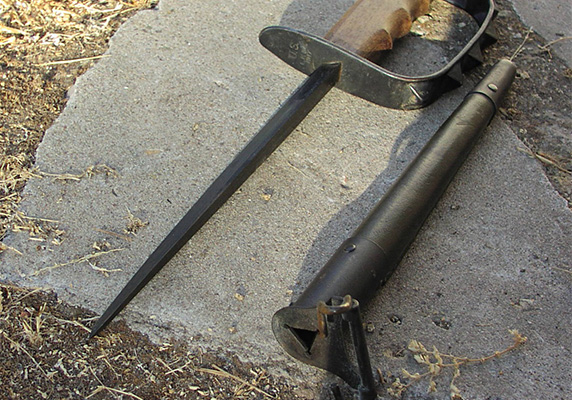
Through fighting with these remedial weapons, troops soon realized they had to refine their designs. The French Army introduced the Poignard-Baïonnette Lebel M1886/14, a type of stiletto which was approved as a standard military weapon. The French Army had such a great need for knives that they demobilized cutlery workers so that they could begin creating knives for service.
For German troops, the Nahkampfmesser was the standard issue weapon during World War I. They had slab wooden grips and metal sheathes. When facing the “French Nail”, Germans began to convert the stakes that held barbed wire.
By George Chernilevsky
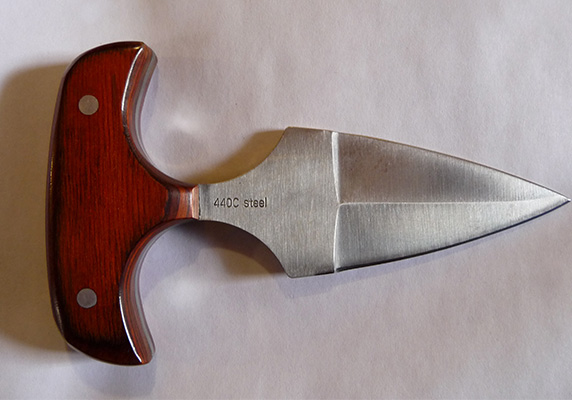
The British Army and Commonwealth allies employed a weapon similar to the Bowie knife, as well as the push dagger. The latter was a T-handled knife that could be grasped so that the blade protruded between the index and middle finger. It is thought to have originated from India and similar to the Katar, one of the most famous Indian weapons. The typical Robbins-Dudley push dagger, known as a “punch knife” by its maker, had a blackened metal spike so that it would not reflect moonlight during nightly raids.